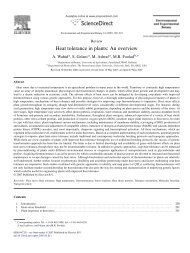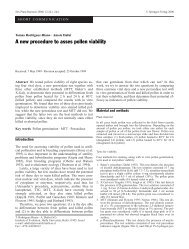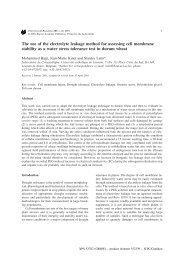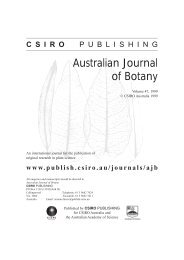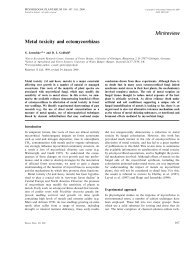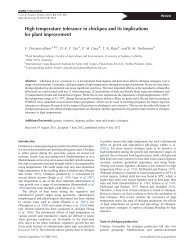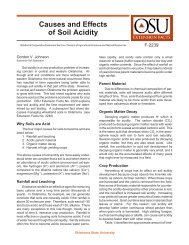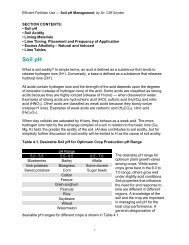Australian Trees for the Rehabilitation of Waterlogged and Salinity ...
Australian Trees for the Rehabilitation of Waterlogged and Salinity ...
Australian Trees for the Rehabilitation of Waterlogged and Salinity ...
You also want an ePaper? Increase the reach of your titles
YUMPU automatically turns print PDFs into web optimized ePapers that Google loves.
700 D. T. Bell<br />
damaged agricultural catchments must tolerate seasonal waterlogging <strong>and</strong> increased soil<br />
salinities, as well as provide some farm income. Particular native <strong>Australian</strong> species that are<br />
naturally found on river flood plains have inherent capabilities to rehabilitate <strong>the</strong> near-stream<br />
perched aquifers <strong>of</strong> damaged agricultural catchments (Bell <strong>and</strong> van der Moezel 1988; Bell<br />
<strong>and</strong> Williams 1997). In fact, flooding is necessary to maximise growth in Eucalyptus<br />
camaldulensis (Bacon et al. 1993) <strong>and</strong> a number <strong>of</strong> species <strong>of</strong> Melaleuca (Watson <strong>and</strong> Bell<br />
1981). An ability to tolerate flooded conditions is <strong>the</strong> first prerequisite <strong>for</strong> species required to<br />
rehabilitate recharge zones in catchments. Natural patterns <strong>of</strong> flood-zone distributions <strong>and</strong><br />
extensive experimental evidence have indicated that Eucalyptus is generally more tolerant <strong>of</strong><br />
waterlogging <strong>and</strong> salinity than Acacia, but less tolerant than Melaleuca <strong>and</strong> Casuarina<br />
(Table 1). The per<strong>for</strong>mance <strong>of</strong> particular species, however, provides exceptions to this<br />
generalisation (van der Moezel <strong>and</strong> Bell 1990; Hussain et al. 1994). This genetic variation is<br />
<strong>the</strong> key to <strong>the</strong> selection <strong>of</strong> tolerant genotypes (Allen et al. 1994; Flowers <strong>and</strong> Yeo 1995).<br />
Table 1. Relative salt/waterlogging tolerance levels <strong>of</strong> <strong>Australian</strong> tree species<br />
from a range <strong>of</strong> published sources<br />
Very highly tolerant (tolerates waterlogging with 400 mM NaCl)<br />
Casuarina equisetifolia 1,9 M. glomerata 1<br />
C. glauca 1,6,9,11 M. halmaturorum 1,11<br />
C. obesa 1,9 M. lanceolata 11<br />
Melaleuca acuminata 1 M. lateriflora 1<br />
M. bracteata 6 M. leucadendra 5,11<br />
M. aff. calycina 10 M. subtrigona 10<br />
M. cardiophylla 10 M. squarrosa 11<br />
M. cuticularis 11 M. styphelioides 11<br />
M. cymbifolia 10 M. thyoides 1,10<br />
M. decussata 11 M. uncinata 11<br />
M. eleuterostachya 1 Highly tolerant (tolerates 300 mM NaCl)<br />
Acacia stenophylla 1,11 E. sargentii 1,7,8,11<br />
Casuarina crista 5,9,11 E. spathulata 1,7,8,11<br />
Eucalyptus camaldulensis 1,2,5,6,8,11 E. intertexta 1<br />
E. campaspe 11 E. micro<strong>the</strong>ca 1<br />
E. cladocalyx var. nana 7,8 E. raveretiana 1,6<br />
E. halophila 10 E. striaticalyx 1<br />
E. kondininensis 11 E. tereticornis 1,6<br />
E. occidentalis 1,8,10,11<br />
Moderately tolerant (tolerates 200 mM NaCl)<br />
Acacia ampliceps 11 E. leptocalyx 10<br />
A. aff. lineolata 4 E. leucoxylon 8<br />
A. auriculi<strong>for</strong>mis 5 E. maculata 2<br />
A. mutabilis subsp. stipulifera 4 E. moluccana 2,6<br />
A. salicina 11 E. ovata 11<br />
Casuarina cunninghamiana 5,6,9,11 E. patens 8<br />
Eucalyptus aggregata 11<br />
E. platypus var.<br />
heterophylla 7,8<br />
E. argophloia 2 E. redunca 8<br />
E. camphora 11 E. robusta 2,6,8,11<br />
E. cladocalyx 8 E. rudis 11<br />
E. drepanophylla 2 E. tereticornis 11<br />
E. floctoniae 8 E. uncinata 10<br />
E. goniantha 10 E. w<strong>and</strong>oo 8



